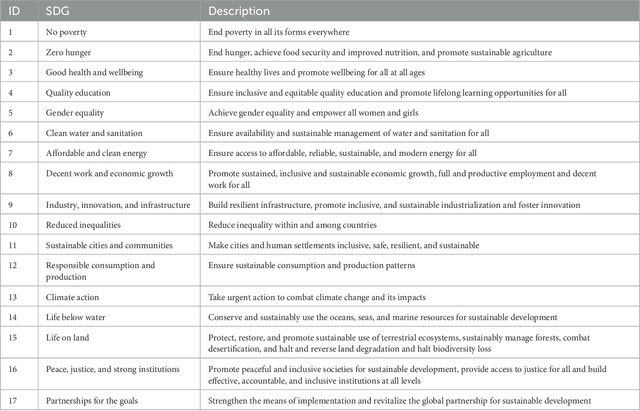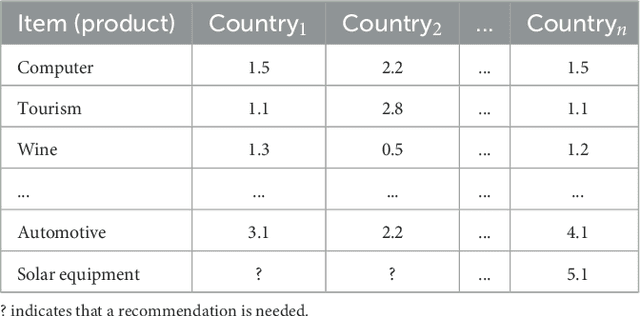Sebastian Lubos
Sustainability Evaluation Metrics for Recommender Systems
Jul 30, 2025Abstract:Sustainability-oriented evaluation metrics can help to assess the quality of recommender systems beyond wide-spread metrics such as accuracy, precision, recall, and satisfaction. Following the United Nations`s sustainable development goals (SDGs), such metrics can help to analyse the impact of recommender systems on environmental, social, and economic aspects. We discuss different basic sustainability evaluation metrics for recommender systems and analyze their applications.
Recommender Systems for Sustainability: Overview and Research Issues
Dec 04, 2024



Abstract:Sustainability development goals (SDGs) are regarded as a universal call to action with the overall objectives of planet protection, ending of poverty, and ensuring peace and prosperity for all people. In order to achieve these objectives, different AI technologies play a major role. Specifically, recommender systems can provide support for organizations and individuals to achieve the defined goals. Recommender systems integrate AI technologies such as machine learning, explainable AI (XAI), case-based reasoning, and constraint solving in order to find and explain user-relevant alternatives from a potentially large set of options. In this article, we summarize the state of the art in applying recommender systems to support the achievement of sustainability development goals. In this context, we discuss open issues for future research.
Less is More: Towards Sustainability-Aware Persuasive Explanations in Recommender Systems
Sep 27, 2024Abstract:Recommender systems play an important role in supporting the achievement of the United Nations sustainable development goals (SDGs). In recommender systems, explanations can support different goals, such as increasing a user's trust in a recommendation, persuading a user to purchase specific items, or increasing the understanding of the reasons behind a recommendation. In this paper, we discuss the concept of "sustainability-aware persuasive explanations" which we regard as a major concept to support the achievement of the mentioned SDGs. Such explanations are orthogonal to most existing explanation approaches since they focus on a "less is more" principle, which per se is not included in existing e-commerce platforms. Based on a user study in three item domains, we analyze the potential impacts of sustainability-aware persuasive explanations. The study results are promising regarding user acceptance and the potential impacts of such explanations.
Sports Recommender Systems: Overview and Research Issues
Dec 06, 2023



Abstract:Sports recommender systems receive an increasing attention due to their potential of fostering healthy living, improving personal well-being, and increasing performances in sport. These systems support people in sports, for example, by the recommendation of healthy and performance boosting food items, the recommendation of training practices, talent and team recommendation, and the recommendation of specific tactics in competitions. With applications in the virtual world, for example, the recommendation of maps or opponents in e-sports, these systems already transcend conventional sports scenarios where physical presence is needed. On the basis of different working examples, we present an overview of sports recommender systems applications and techniques. Overall, we analyze the related state-of-the-art and discuss open research issues.
Solving Multi-Configuration Problems: A Performance Analysis with Choco Solver
Oct 19, 2023

Abstract:In many scenarios, configurators support the configuration of a solution that satisfies the preferences of a single user. The concept of \emph{multi-configuration} is based on the idea of configuring a set of configurations. Such a functionality is relevant in scenarios such as the configuration of personalized exams, the configuration of project teams, and the configuration of different trips for individual members of a tourist group (e.g., when visiting a specific city). In this paper, we exemplify the application of multi-configuration for generating individualized exams. We also provide a constraint solver performance analysis which helps to gain some insights into corresponding performance issues.
Concentrating on the Impact: Consequence-based Explanations in Recommender Systems
Aug 31, 2023
Abstract:Recommender systems assist users in decision-making, where the presentation of recommended items and their explanations are critical factors for enhancing the overall user experience. Although various methods for generating explanations have been proposed, there is still room for improvement, particularly for users who lack expertise in a specific item domain. In this study, we introduce the novel concept of \textit{consequence-based explanations}, a type of explanation that emphasizes the individual impact of consuming a recommended item on the user, which makes the effect of following recommendations clearer. We conducted an online user study to examine our assumption about the appreciation of consequence-based explanations and their impacts on different explanation aims in recommender systems. Our findings highlight the importance of consequence-based explanations, which were well-received by users and effectively improved user satisfaction in recommender systems. These results provide valuable insights for designing engaging explanations that can enhance the overall user experience in decision-making.
Conjunctive Query Based Constraint Solving For Feature Model Configuration
Apr 26, 2023Abstract:Feature model configuration can be supported on the basis of various types of reasoning approaches. Examples thereof are SAT solving, constraint solving, and answer set programming (ASP). Using these approaches requires technical expertise of how to define and solve the underlying configuration problem. In this paper, we show how to apply conjunctive queries typically supported by today's relational database systems to solve constraint satisfaction problems (CSP) and -- more specifically -- feature model configuration tasks. This approach allows the application of a wide-spread database technology to solve configuration tasks and also allows for new algorithmic approaches when it comes to the identification and resolution of inconsistencies.
 Add to Chrome
Add to Chrome Add to Firefox
Add to Firefox Add to Edge
Add to Edge